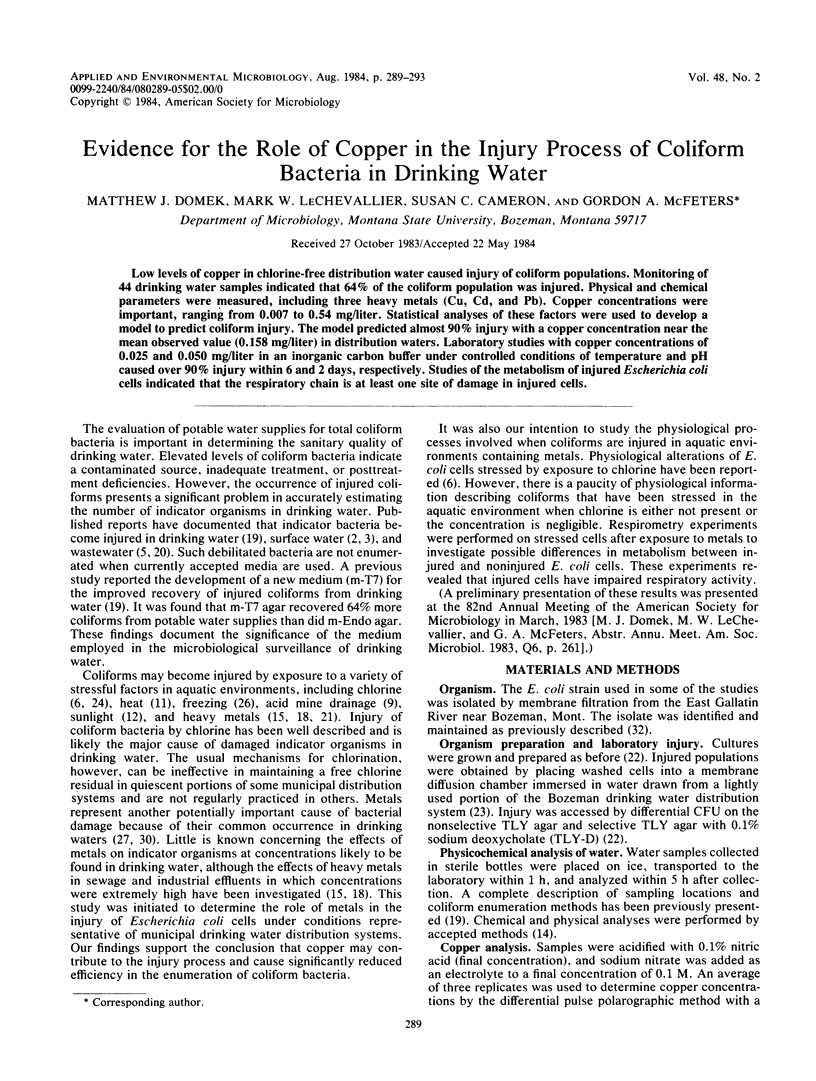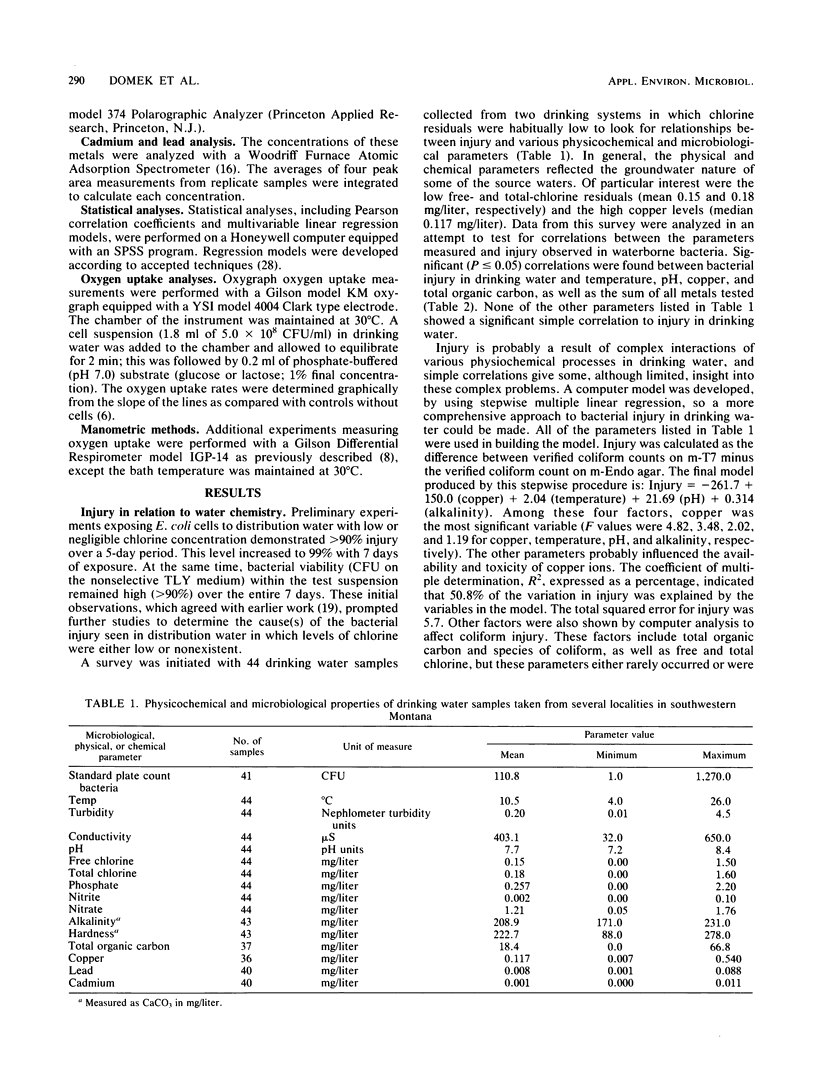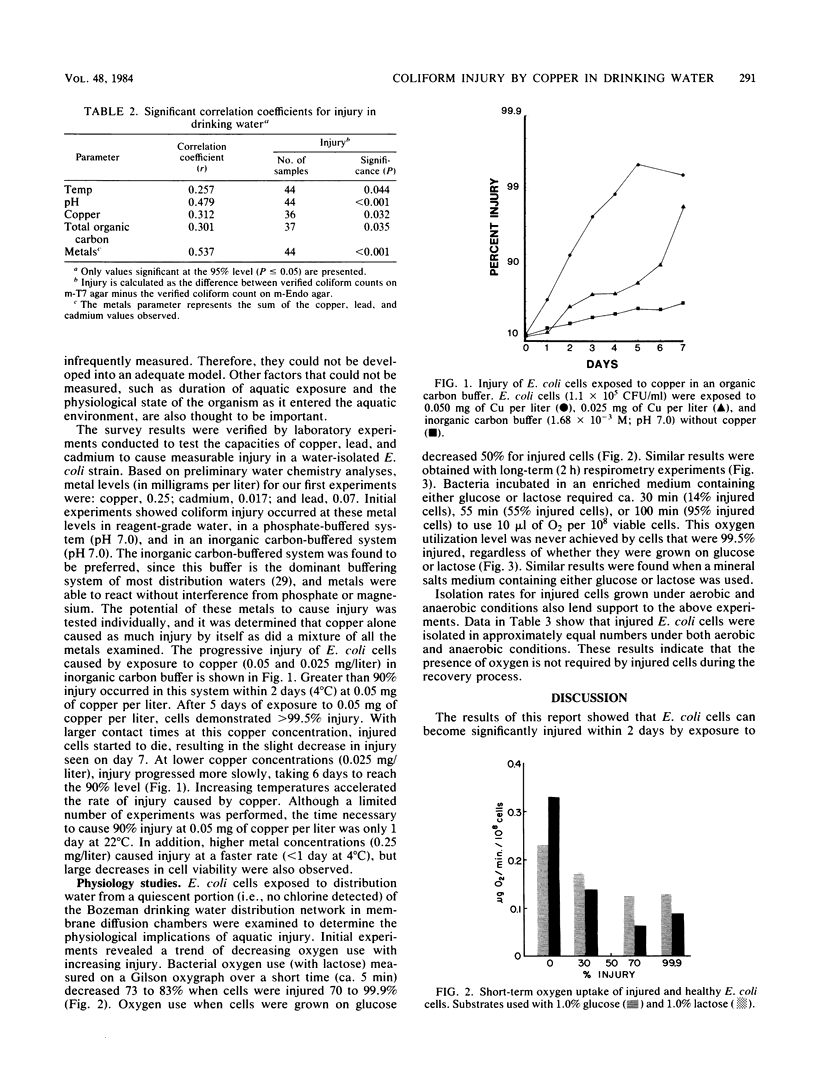Abstract
Low levels of copper in chlorine-free distribution water caused injury of coliform populations. Monitoring of 44 drinking water samples indicated that 64% of the coliform population was injured. Physical and chemical parameters were measured, including three heavy metals (Cu, Cd, and Pb). Copper concentrations were important, ranging from 0.007 to 0.54 mg/liter. Statistical analyses of these factors were used to develop a model to predict coliform injury. The model predicted almost 90% injury with a copper concentration near the mean observed value (0.158 mg/liter) in distribution waters. Laboratory studies with copper concentrations of 0.025 and 0.050 mg/liter in an inorganic carbon buffer under controlled conditions of temperature and pH caused over 90% injury within 6 and 2 days, respectively. Studies of the metabolism of injured Escherichia coli cells indicated that the respiratory chain is at least one site of damage in injured cells.
Full text
PDF




Selected References
These references are in PubMed. This may not be the complete list of references from this article.
- Babich H., Stotzky G. Environmental factors that influence the toxicity of heavy metal and gaseous pollutants to microorganisms. Crit Rev Microbiol. 1980;8(2):99–145. doi: 10.3109/10408418009081123. [DOI] [PubMed] [Google Scholar]
- Bissonnette G. K., Jezeski J. J., McFeters G. A., Stuart D. G. Influence of environmental stress on enumeration of indicator bacteria from natural waters. Appl Microbiol. 1975 Feb;29(2):186–194. doi: 10.1128/am.29.2.186-194.1975. [DOI] [PMC free article] [PubMed] [Google Scholar]
- Braswell J. R., Hoadley A. W. Recovery of Escherichia coli from chlorinated secondary sewage. Appl Microbiol. 1974 Aug;28(2):328–329. doi: 10.1128/am.28.2.328-329.1974. [DOI] [PMC free article] [PubMed] [Google Scholar]
- Camper A. K., McFeters G. A. Chlorine injury and the enumeration of waterborne coliform bacteria. Appl Environ Microbiol. 1979 Mar;37(3):633–641. doi: 10.1128/aem.37.3.633-641.1979. [DOI] [PMC free article] [PubMed] [Google Scholar]
- Dockins W. S., McFeters G. A. Fecal coliform elevated-temperature test: a physiological basis. Appl Environ Microbiol. 1978 Aug;36(2):341–348. doi: 10.1128/aem.36.2.341-348.1978. [DOI] [PMC free article] [PubMed] [Google Scholar]
- Egan A. F. Enumeration of stressed cells of Escherichia coli. Can J Microbiol. 1979 Jan;25(1):116–118. doi: 10.1139/m79-018. [DOI] [PubMed] [Google Scholar]
- Fujioka R. S., Hashimoto H. H., Siwak E. B., Young R. H. Effect of sunlight on survival of indicator bacteria in seawater. Appl Environ Microbiol. 1981 Mar;41(3):690–696. doi: 10.1128/aem.41.3.690-696.1981. [DOI] [PMC free article] [PubMed] [Google Scholar]
- LeChevallier M. W., Cameron S. C., McFeters G. A. New medium for improved recovery of coliform bacteria from drinking water. Appl Environ Microbiol. 1983 Feb;45(2):484–492. doi: 10.1128/aem.45.2.484-492.1983. [DOI] [PMC free article] [PubMed] [Google Scholar]
- Lin S. Evaluation of coliform tests for chlorinated secondary effluents. J Water Pollut Control Fed. 1973 Mar;45(1):498–506. [PubMed] [Google Scholar]
- MILBAUER R., GROSSOWICZ N. Reactivation of chlorine-inactivated Escherichia coli. Appl Microbiol. 1959 Mar;7(2):67–70. doi: 10.1128/am.7.2.67-70.1959. [DOI] [PMC free article] [PubMed] [Google Scholar]
- MacLeod R. A., Kuo S. C., Gelinas R. Metabolic injury to bacteria. II. Metabolic injury induced by distilled water or Cu++ in the plating diluent. J Bacteriol. 1967 Mar;93(3):961–969. doi: 10.1128/jb.93.3.961-969.1967. [DOI] [PMC free article] [PubMed] [Google Scholar]
- McFeters G. A., Cameron S. C., LeChevallier M. W. Influence of diluents, media, and membrane filters on detection fo injured waterborne coliform bacteria. Appl Environ Microbiol. 1982 Jan;43(1):97–103. doi: 10.1128/aem.43.1.97-103.1982. [DOI] [PMC free article] [PubMed] [Google Scholar]
- McFeters G. A., Stuart D. G. Survival of coliform bacteria in natural waters: field and laboratory studies with membrane-filter chambers. Appl Microbiol. 1972 Nov;24(5):805–811. doi: 10.1128/am.24.5.805-811.1972. [DOI] [PMC free article] [PubMed] [Google Scholar]
- Moran J. W., Smith T. L., Witter L. D. Effect of potential water pollutants and enzyme inhibitors on an automated rapid test for Escherichia coli. Appl Environ Microbiol. 1976 Oct;32(4):645–646. doi: 10.1128/aem.32.4.645-646.1976. [DOI] [PMC free article] [PubMed] [Google Scholar]
- Moss C. W., Speck M. L. Release of biologically active peptides from Escherichia coli at subzero temperatures. J Bacteriol. 1966 Mar;91(3):1105–1111. doi: 10.1128/jb.91.3.1105-1111.1966. [DOI] [PMC free article] [PubMed] [Google Scholar]
- Ridgway H. F., Olson B. H. Chlorine resistance patterns of bacteria from two drinking water distribution systems. Appl Environ Microbiol. 1982 Oct;44(4):972–987. doi: 10.1128/aem.44.4.972-987.1982. [DOI] [PMC free article] [PubMed] [Google Scholar]
- Zaske S. K., Dockins W. S., Schillinger J. E., McFeters G. A. New methods to assess bacterial injury in water. Appl Environ Microbiol. 1980 Mar;39(3):656–658. doi: 10.1128/aem.39.3.656-658.1980. [DOI] [PMC free article] [PubMed] [Google Scholar]


